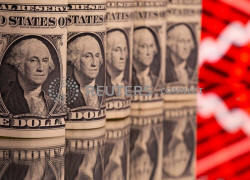Dollar firm as COVID-19 resurgence hits reflation trades
 Send a link to a friend
Send a link to a friend
 [April 21, 2021] By
Saikat Chatterjee [April 21, 2021] By
Saikat Chatterjee
LONDON (Reuters) - The U.S. dollar rose on
Wednesday from a seven-week low hit overnight, as broad weakness in
stock markets triggered by a resurgence of COVID-19 cases in countries
from India to Japan fuelled renewed appetite for the safe-haven appeal
of the greenback.
The safety bid also supported the Swiss franc and the Japanese yen as
the outlook for the global economy soured.
The greenback has weakened more than 2% in April after a strong March
rally as investors bet that a global economic recovery premised on a
speedy rollout of vaccines would fuel demand for non-dollar currencies
like the euro and the Aussie.
The dollar index, which tracks the U.S. currency against six major
peers, was up 0.11% at 91.321 in London trading after slumping as low as
90.856 on Tuesday for the first time since March 3.

The greenback's bounce was also accompanied by softer U.S. Treasury
yields as investors weighed the surge in COVID-19 cases against a
broad-based selloff in the U.S. dollar in recent weeks despite strong
U.S. employment and retail sales data.
Thu Lan Nguyen, a strategist at Commerzbank said more positive U.S. data
could easily kick-start another dollar rally, particularly if the uneven
pace of vaccinations fuels greater demand for U.S. Treasuries as a hedge
against a crisis.
"So for now, U.S. dollar bears should make sure that they donít get
excited too soon," she said in a note.
The benchmark 10-year Treasury yield was around 1.58%, not far from its
lowest since mid-March, as it continued to consolidate following its
retreat from the 14-month high at 1.7760% reached at the end of last
month.
The biggest casualty of the dollar's rise in London trading was the euro
with the single currency weakening 0.25% at $1.2000, after touching a
seven-week high of $1.2079 overnight.
[to top of second column] |

U.S. one dollar banknotes are seen in front of displayed stock graph
in this illustration taken February 8, 2021. REUTERS/Dado Ruvic/Illustration/File
Photo

While the euro has benefited from the dollar's weakness in recent weeks,
Georgette Boele, an economist at ABN Amro believes the euro is likely to weaken
further in coming days due to U.S. economic outperformance and repricing of ECB
rate expectations.
She expects the euro to weaken to $1.15 by the end of 2021.
The European Central Bank decides policy on Thursday, with the Federal Reserve
following next week.
Declines in U.S. yields and the dollar in April have come as evidence mounted
that the Fed would be slower in tightening monetary policy than it had appeared
to the market.
Broadly, pandemic developments triggered investor caution.
India reported its highest daily toll of 1,761 deaths from COVID-19, while
Canada and the United States extended a land-border closure for non-essential
travellers.
The Australian dollar, a barometer for risk appetite, nursed losses at $0.7717
after weakening 0.4% overnight.
In cryptocurrencies, bitcoin traded around $55,000, consolidating following its
dip to as low as $51,541.16 on Sunday. It set a record high at $64,895.22 on
April 14.
For a graphic on EURUSD and CESI:
https://fingfx.thomsonreuters.com/
gfx/mkt/yzdpxbkwdpx/EURUSD%20and%20CESI.JPG
(Reporting by Saikat Chatterjee; Editing by Barbara Lewis and Hugh Lawson
[© 2021 Thomson Reuters. All rights
reserved.] Copyright 2021 Reuters. All rights reserved. This material may not be published,
broadcast, rewritten or redistributed.
Thompson Reuters is solely responsible for this content. |